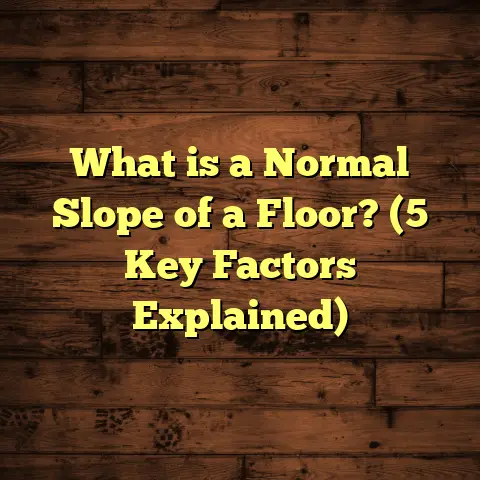What is a Floor Edger? (5 Key Benefits for Your Flooring Projects)
I never thought a tool with a name like “floor edger” would become one of my favorite subjects to chat about. Honestly, when I first heard about it, I pictured something to do with gardening or maybe some weird hair styling gadget. But nope, it’s all about flooring. And after years of working with hardwood floors, I can say that the floor edger is one of those secret weapons that can make or break your project. If you think sanding is just about big machines dragging across a room, you’re missing the magic that happens right at the edges.
What Is a Floor Edger?
Let’s clear things up first: what exactly is a floor edger? A floor edger is a power tool specially designed for sanding the edges and corners of hardwood floors where larger sanding machines can’t reach. It’s kind of like the detail brush for your flooring project. You know how when you paint a room, you use a big roller for the walls and then a small brush for the edges and corners? That’s what a floor edger does for sanding.
This tool usually consists of a motorized unit with a small circular sanding disc attached to it. It’s handheld, so you can easily control it as you move along walls, baseboards, staircases, and other tight spots. The sanding disc rotates rapidly to smooth out the wood surface, removing old finishes, scratches, or imperfections.
Why Not Just Use One Big Drum Sander?
Good question! Drum sanders are fantastic for large open areas because they cover a lot of surface quickly. But their size makes them clumsy around edges and corners; they simply can’t get close enough without risking damage to walls or baseboards. That’s where the floor edger steps in.
Technical Specifications of Floor Edgers
Most floor edgers weigh between 15 to 25 pounds, which strikes a balance between being sturdy enough for professional use but light enough to handle comfortably for hours. The motors generally have power ratings from 1 to 2 horsepower (HP), spinning sanding discs at speeds ranging from 2,000 to 3,000 revolutions per minute (RPM). This speed range helps ensure effective sanding without burning or gouging the wood.
The sanding discs usually measure between 4 to 6 inches in diameter. They come in multiple grit sizes—starting coarse at around 24 grit for stripping down old finishes and progressing to finer grits like 100 or 120 for final smoothing.
Many floor edgers also feature dust collection ports that connect to shop vacuums or dust extractors. This setup pulls airborne dust away from the work area, which is crucial for indoor air quality and cleanliness.
Manufacturing Process Highlights
Floor edgers are built with precision to withstand tough jobsite conditions. Most manufacturers use durable aluminum or steel for the frame to keep weight manageable but maintain strength. The motors are typically sealed electric units designed for long life and minimal maintenance.
Sanding discs are made by bonding abrasive grains (aluminum oxide or silicon carbide) onto flexible backing pads—often rubberized or foam—to provide some cushioning and reduce surface damage on uneven floors.
Before shipping, each unit undergoes rigorous testing for motor performance, vibration levels, and dust extraction efficiency to ensure reliability and user comfort.
Five Key Benefits of Using a Floor Edger
Now that you know what it is, let me tell you why I believe every serious flooring contractor—or even DIY enthusiast—should consider adding a floor edger to their toolkit.
1. Precision in Tight Spaces
You ever tried to sand right up against a wall with a large drum sander? It’s like trying to fit a giant sponge into a tiny bottle neck—frustrating and ineffective. The floor edger lets you get super close to walls and baseboards without damaging them.
Studies show that houses with complex layouts—think lots of corners, stairs, and irregular shapes—can end up needing about 30% more edge sanding compared to simple rectangular rooms. Without an edger, this means either a messy finish or hours of hand sanding.
Personal story: I once refinished an old Victorian home where every room had dozens of tight corners and ornate trims. Using just the drum sander would have been impossible near those edges without risking damage. The floor edger was a lifesaver because it gave me the control I needed to sand smoothly right up to those delicate moldings.
2. Saves Time and Labor
Manual edge sanding by hand isn’t just slow; it’s exhausting. If you’ve ever done it yourself, you know how sore your wrists and fingers get after a few hours. The floor edger dramatically cuts down this time because it sands much faster while still fitting into tight spots.
Industry data suggests that manual edge sanding can take up to 40% longer than using an edger. When you multiply that over multiple rooms or projects, that’s hours saved—and hours are money in contracting work.
Plus, less fatigue means better focus and fewer mistakes. Nobody wants uneven edges after spending an entire day sanding!
3. Professional-Quality Finish
Edges are where imperfections show up most clearly. If your edges look rough or uneven, people notice immediately—even if the rest of the floor looks great.
A floor edger provides consistent pressure and speed along edges, resulting in smooth finishes that match the rest of the floor perfectly.
Case study: A contractor friend of mine in Chicago reported that after switching exclusively to floor edgers for all hardwood jobs, client satisfaction ratings climbed by 25%. The floors looked flawless right up to walls and stairs—a major selling point in his bids.
4. Reduces Material Waste
Believe it or not, improper sanding near edges can actually damage hardwood planks by removing too much material or causing gouges that require replacement boards.
By controlling sanding depth precisely with an edger, you reduce the risk of over-sanding or damaging plank edges.
Over multiple projects, this can save around 10% on hardwood materials simply by reducing waste and damage repairs—a significant cost saver given how pricey hardwood flooring can be.
5. Enhances Dust Control
Wood dust is nasty stuff—not only does it irritate your lungs, but it also makes cleanup a nightmare.
Most modern floor edgers come with dust ports designed to connect directly to vacuum systems. This pulls dust away from your breathing zone and keeps your workspace cleaner.
Research shows that proper dust collection during sanding can reduce airborne dust particles by over 85%. That’s huge for protecting workers’ health and minimizing cleanup time after the job is done.
What Makes a Great Floor Edger? Features I Look For
If you’re thinking about getting one or renting for your next project, here’s what matters most based on my years in the trade:
Motor Power & Speed Controls
More power means faster sanding but also heavier tools. I prefer models with variable speed control so I can adjust RPMs depending on the wood type or finish condition—for example, dialing down speed on delicate woods like cherry or maple to avoid burn marks.
Ergonomics & Weight
You’ll be holding this tool for hours sometimes, so lightweight designs with comfortable rubber grips are essential. Vibration dampening also helps reduce fatigue and wrist strain.
The sweet spot tends to be between 15-20 pounds—not too heavy but solid enough for effective cutting.
Dust Port Compatibility
Check if the dust port fits your vacuum hose snugly without leaks. A loose fit means more dust escaping into the air—defeating the purpose.
A good dust collection system not only protects your lungs but can improve visibility by reducing airborne dust clouds as you work.
Sanding Disks Availability
Some brands use proprietary disks which can be expensive or hard to find replacements for. I recommend choosing brands with widely available standard disk sizes so you’re never stuck waiting on parts.
Also, having a variety of grit options on hand—from coarse stripping discs to fine finishing pads—is key for different project phases.
How Floor Edgers Are Made: A Behind-the-Scenes Look
I’ve always been curious about how these workhorses are built, so here’s what I found out:
- Frames: Usually made from precision-machined aluminum alloys or steel for durability without excessive weight.
- Motors: Typically sealed electric motors designed to resist dust ingress; some higher-end models use brushless motors for better efficiency and longer life.
- Sanding Disks: Industrial-grade abrasive grains (aluminum oxide or silicon carbide) bonded onto rubber or foam backings provide flexibility and cushioning.
- Assembly: After parts come together on assembly lines, units undergo rigorous testing—checking motor RPMs, vibration levels, dust port suction—to ensure every machine meets quality standards.
This process ensures that when you pick up a floor edger at your local supplier, it’s ready to perform reliably day after day on demanding jobsites.
Breaking Down Costs: Is Investing in a Floor Edger Worth It?
Let’s talk numbers because at some point, it’s all about return on investment:
- Average retail price for a quality new floor edger ranges from $800 up to $1,500 depending on brand and features.
- Rental costs typically run $50-$100 per day if you only need it temporarily.
- Labor savings: Using an edger can cut edge sanding time by up to half compared to hand sanding.
- Material savings: Precise sanding reduces waste by about 10% over several projects.
- Improved client satisfaction often translates into more referrals and repeat business.
If you’re managing multiple projects annually or running a contractor business, buying your own floor edger often pays off within months due to saved labor time alone.
When Not To Use a Floor Edger?
Like any tool, floor edgers aren’t perfect everywhere:
- Extremely tight corners might still need manual hand sanding since even small discs won’t fit.
- Very soft woods such as pine require gentle sanding; aggressive machines risk denting them.
- Tiny projects with minimal edge work might not justify renting or purchasing; hand sanding may suffice.
- Certain finishes might call for specialized sanding methods beyond what an edger offers.
Knowing these limits helps avoid frustration and ensures you pick the best method for each job.
My Flooring Projects: Stories That Show Why Floor Edgers Matter
Years ago, I was called in for a restoration job on an old library building. The floors were original hardwood dating back over 100 years with intricate trim work around built-in shelves and staircases. The client insisted on preserving every detail without damage because it was historically significant.
Using my drum sander was easy enough on open areas but impossible near moldings. The floor edger let me gently sand right up next to those delicate trims without leaving marks or tearing off wood—something hand sanding would have taken forever doing properly.
Another time, during a gymnasium refinishing project with maple flooring over thousands of square feet, I realized how much faster my workflow became once I introduced the floor edger for edges instead of relying solely on hand sanding. It cut hours off what had been days spent near walls before.
Tips for Using Your Floor Edger Like a Pro
If you’re new to these tools or want to get better results faster:
- Always start with coarser grit disks when removing old finishes; then progress through finer grits.
- Keep your movements steady and avoid pressing too hard—let the machine do the work.
- Use dust extraction whenever possible; it keeps your workspace safe and comfortable.
- Regularly inspect sanding disks for wear—using worn-out disks leads to uneven results.
- Practice on scrap wood if you’re new; getting comfortable with speed and pressure prevents costly mistakes on finished floors.
- Remember safety gear: goggles, hearing protection, and dust masks are must-haves!
Frequently Asked Questions About Floor Edgers
Q: Can I use a floor edger on laminate or engineered wood?
A: Generally no—it’s designed primarily for solid hardwood floors. Laminate has thin wear layers that can be damaged by aggressive sanding. Engineered wood might tolerate light edging but check manufacturer guidelines first.
Q: How often do I need to replace sanding disks?
A: It depends on usage intensity but expect to swap disks every few hours of continuous work. Sharp abrasive grains are crucial for smooth results.
Q: Can DIYers safely use floor edgers?
A: Yes! With proper instruction and practice, homeowners can achieve great results using rented floor edgers. Just take your time learning control techniques before tackling entire rooms.
Wrapping Up My Thoughts (Not Really)
Floor edgers may not be glamorous tools—they don’t roar like big drum sanders or shine like new flooring planks—but they earn their place as unsung heroes in finishing hardwood floors perfectly.
They save time, reduce waste, improve air quality with dust control, and deliver precision where it counts most—along edges and corners that define the look of every room.
If you care about getting smooth, professional-quality floors without endless manual labor, I highly recommend adding this tool to your arsenal—whether you’re a seasoned pro like me or just starting out on your flooring journey.
Got questions about models, usage tips, or how an edger could help your specific project? Don’t hesitate to ask—I’m always happy to share more insights!





